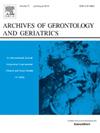在衰老过程中抑制 Nrf2 通路会降低白藜芦醇的抗炎作用。
IF 3.8
3区 医学
Q2 GERIATRICS & GERONTOLOGY
引用次数: 0
摘要
在衰老过程中,除了氧化应激增加外,炎症也会发生。慢性和低水平的炎症--被称为 "炎症老化"--会导致与衰老有关的疾病。白藜芦醇(Resv.)是一种多酚,以其生物活性特性(如抗氧化和抗炎特性)而闻名。Nrf2 是一种转录因子,通过表达或抑制某些基因来调节细胞对氧化剂的防御能力。研究的目的是评估 Nrf2 对白藜芦醇(5 微米)处理不同年龄段白细胞产生细胞因子的影响。实验对象分为三组:20-39 岁、40-59 岁和 60-80 岁。在分离白细胞后,使用或不使用 ML385 抑制剂进行 24 小时处理:对照组、Resv、过氧化物和过氧化物+Resv。设置 150 µM 过氧化物以形成氧化环境。细胞因子通过 ELISA 检测(*p < 0.05)。一般来说,与对照组相比,受过氧化物刺激的细胞中 TNF 和 IL-6 增加。用白藜芦醇处理过的细胞,无论是在基础水平还是在氧化环境(过氧化物)中,这两种细胞因子都有所下降。多酚仅在最年轻的年龄组中能够增加 IL-10。用 ML385 抑制 Nrf2 通路时,在相同组别中也观察到了相同的情况。由此得出结论,白藜芦醇在防止衰老过程中出现的氧化和炎症方面可能有更好的效果,尤其是通过抗氧化和抗炎症的 Nrf2 途径。本文章由计算机程序翻译,如有差异,请以英文原文为准。
Silencing of the Nrf2 pathway in aging promotes a decrease in the anti-inflammatory effect of resveratrol
During aging, in addition to increased oxidative stress, inflammation also occurs. A chronic and low-grade inflammation - called “inflammaging” - develops, which contributes to the etiology of diseases related to aging. Resveratrol (Resv.) is a polyphenol well known for its biologically active properties, such as antioxidant and anti-inflammatory properties. This balance can be regulated by Nrf2 - a transcription factor that regulates cellular defense against oxidative agents through the expression or inhibition of certain genes. The objective was to evaluate the effect of Nrf2 on the production of cytokines in leukocytes of different ages treated with resveratrol (5µm). The subjects were divided into three groups: 20–39, 40–59 and 60–80 years old. After separation of the leukocytes, a 24-hour treatment was carried out with and without ML385 inhibitor with the treatments: Control, Resv, Peroxide and Peroxide+Resv. 150 µM peroxide was set to develop an oxidative environment. Cytokines were measured by ELISA (*p < 0.05). In general, there was an increase in TNF and IL-6 in cells stimulated with peroxide compared to controls. A decrease in these two cytokines was also observed in cells treated with resveratrol, both at basal levels and in an oxidizing environment (with peroxide). The polyphenol was able to increase IL-10 only in the youngest age groups. The same profile was observed comparing the same groups when the Nrf2 pathway was inhibited with ML385. It is concluded that resveratrol may have a better effect on preventing oxidation and inflammation present in aging, especially through the antioxidant and anti-inflammatory Nrf2 pathway.
求助全文
通过发布文献求助,成功后即可免费获取论文全文。
去求助
来源期刊
CiteScore
7.30
自引率
5.00%
发文量
198
审稿时长
16 days
期刊介绍:
Archives of Gerontology and Geriatrics provides a medium for the publication of papers from the fields of experimental gerontology and clinical and social geriatrics. The principal aim of the journal is to facilitate the exchange of information between specialists in these three fields of gerontological research. Experimental papers dealing with the basic mechanisms of aging at molecular, cellular, tissue or organ levels will be published.
Clinical papers will be accepted if they provide sufficiently new information or are of fundamental importance for the knowledge of human aging. Purely descriptive clinical papers will be accepted only if the results permit further interpretation. Papers dealing with anti-aging pharmacological preparations in humans are welcome. Papers on the social aspects of geriatrics will be accepted if they are of general interest regarding the epidemiology of aging and the efficiency and working methods of the social organizations for the health care of the elderly.

 求助内容:
求助内容: 应助结果提醒方式:
应助结果提醒方式:


